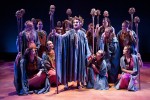The first word that director Eliza Laytner uses to describe her new play, “Women in Congress,” is “edgy” – not a word one would necessarily associate with a play that dates back to 392 B.C.
A UCLA graduate student in directing, Laytner’s production is showing at UCLA’s Little Theater from Tuesday to Saturday. The cast and crew are comprised of more than 30 actors, designers, production crew staffers, composers and a choreographer, with Fatima Elbashir, a third-year theater student, as assistant director.
“Women in Congress,” based on Aristophanes’ ancient Greek text of the same name, is a comedic play about Athenian women attempting to take control of the government by dressing up in drag to fool men into voting for them.
The message, however, is not comical: The women’s goal is empowerment. They want to create a kind of communist state where everyone is equal.
“Thematically, the piece explores questions surrounding feminism, gender and the challenges, resistances and consequences of trying to create change in one’s society,” Laytner said.
Laytner modernized the Aristophanes play narratively by working with classicists Amanda Krauss and Jess Miner’s contemporary translation of the script. She used this translation in order to ensure the play was relatable to a modern audience.
Although the play provides a topical and controversial discussion about women in power, it delivers the content in a comical way. Laytner said she compares Aristophanes to satirical news anchor Jon Stewart because the play and Stewart both mask current affairs issues with lighthearted jokes.
“Both their work attempts the same thing even though they exist thousands of years apart from each other,” she said.
In terms of design, Laytner said she was inspired by Federico Fellini’s “Satyricon,” where characters are highly dramatized and the costumes are very lavish. She showed her designers images from the film and based visuals on those pictures.
The visuals, therefore, are rich with extravagance in the form of royal and garish colors. However, the visuals do not take away from the believability of the characters, Laytner said. Elbashir worked with the actors to develop their characters’ backgrounds in the hopes of giving the play more depth. She held three workshops for actors over the summer to flesh out the scenes so that the internal aspects of the characters translated to the audience.
“In the workshops (we showed actors how to) relate to the space, to themselves and each other,” Elbashir said.
One of the actors, Bruce Alperovich, a third-year theater student, plays the antagonist Belpyros, the husband of Praxagora, the woman orchestrating the rise of women leaders. He said the workshops helped him get increased direction, allowing him to further develop his character.
“There are so many angles that you can approach this from that it’s nice to have some direction and exterior output,” Alperovich said.
Laytner and Elbashir started working on the play over the summer. Laytner said she chose to direct a Greek play because she wanted to work with a text that was infused with music, dance and song.
“I once heard Greek plays are like visual poems and I am very inspired by that sentiment,” she said, “I am also fascinated by how such ancient texts still carry so much weight and relevance today.”
Elbashir said that she was drawn to this play because the themes are still current. Having female leaders is a point of contention in society today, and although the play itself is old, it draws attention to this modern issue.
“(The play is) hugely prevalent now with Hilary Clinton and the presidency and women finding their own and taking (control) for themselves,” Elbashir said.
Despite having an ensemble cast, Elbashir said the chorus, comprised of only women, is the glue holding the play together. The chorus narrates the play, adding continuity between scenes.
“I see my chorus ladies as the camera,” Elbashir said.“They tell you where to look, and what to pay attention to, and what is important as you’re watching the show.”
The ancient Greeks, she said, put a similar amount of importance on the chorus’ role in narrating a production.
“It’s not a musical, but movement and song are a huge part of the show just as movement and song were a huge part of the ancient Greeks’,” Elbashir said.
Laytner said one of the main things that the cast and crew have emphasized is staying true to the ancient Greek roots of the play.
When designing the play, Laytnersaid she ensured that Greek motifs, like the use of gold and white, pay homage to the play’s origins while making it remain relevant to a contemporary audience.
Nevertheless, she said she has still made the play her own, and said audiences should look forward to the original songs and dances.
Laytner also said she not only hopes to make the audience laugh, but also leave the theater thinking about the play’s message of equality.
“Theater is my way of exploring humanity,” she said.
